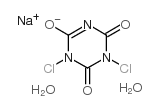| 结构式 | 名称/CAS号 | 全部文献 |
|---|---|---|
 |
二氯异氰尿酸钠
CAS:2893-78-9 |
|
 |
二氯异氰尿酸钠 二水合物
CAS:51580-86-0 |
| 结构式 | 名称/CAS号 | 全部文献 |
|---|---|---|
 |
二氯异氰尿酸钠
CAS:2893-78-9 |
|
 |
二氯异氰尿酸钠 二水合物
CAS:51580-86-0 |